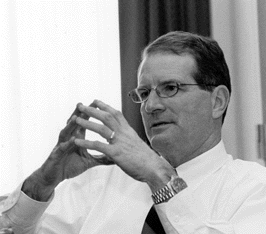
 Hopkins in the new
millennium
Hopkins in the new
millennium
Daniel Coit Gilman had an almost crystal ball-like vision of
the university he was asked to steer 125 years ago. In his
inaugural address, he talked of the not-yet-formed School of
Medicine, "whose remedial and preventive agencies will
extend to thousands who may never come within its walls,"
and of Hopkins facilities and agencies housed in
Washington.
As current university president William R.
Brody contemplates Hopkins' future, he says no such
prophetic details are coming to him in his sleep. Brody says
he is sure of one thing, however: Just as it always has, the
university will continue to evolve by the catalyst of
"knowledge discovery."
Full story...
 Touchdown caps NEAR
mission
Touchdown caps NEAR
mission
At just after 3 p.m. on Feb. 12, the NEAR Shoemaker
spacecraft cruised to the surface of asteroid Eros at a
gentle 4 mph, finally coming to rest after its
2-billion-mile journey. Cheers and congratulations filled
the Mission Operations Center at the Applied Physics
Laboratory--which built the spacecraft and manages the
mission for NASA--when NEAR mission director Robert Farquhar
announced, "I'm happy to say the spacecraft is safely on the
surface of Eros."
Not only safe but also operational. NASA
announced Feb. 14, NEAR's scheduled end date, that it would
extend the mission for up to 10 days to gather data from the
spacecraft's gamma-ray spectrometer, a scientific instrument
that could provide unprecedented information about the
asteroid's surface and subsurface composition. Late last
week, mission operators at APL commanded the instrument to
begin collecting and recording data.
Full story...
| [ The Gazette | Search | About the Gazette | Send us Email ] |
The Gazette
 The Johns Hopkins University
The Johns Hopkins University Suite 100
 3003 N. Charles St.
3003 N. Charles St.
 Baltimore, MD 21218
Baltimore, MD 21218410-516-8514
 gazette@jhu.edu.
gazette@jhu.edu.
